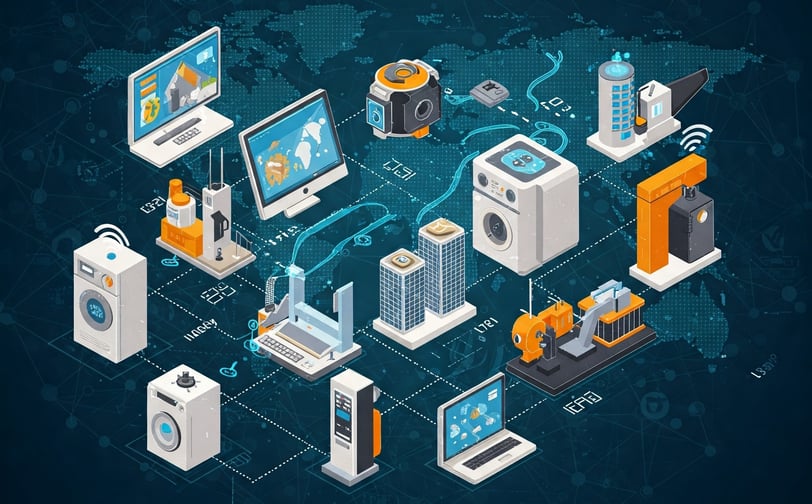Internet of Things (IoT): The Future of Connectivity
The Internet of Things (IoT) is a technological revolution that is transforming how we interact with the world. It involves connecting everyday objects to the internet, enabling data exchange and process automation. From smart appliances to industrial systems, IoT is becoming increasingly prevalent in various fields.
3/16/20252 min read


How Does IoT Work?
IoT operates through devices equipped with sensors, internet connectivity, and processing capabilities. These devices collect data, send it to servers or cloud platforms, where it is processed and turned into useful information. This data can be analyzed and used for automated or human-assisted decision-making.
Examples of Applications
1. IoT in Smart Homes
IoT has enabled the emergence of smart homes, where connected devices make the environment more efficient and comfortable. Some examples include:
Virtual assistants like Alexa and Google Assistant, which control lights, thermostats, and electronic devices, making daily life easier;
Smart refrigerators, such as Samsung Family Hub, which monitor inventory, suggest recipes, and create automatic shopping lists;
Smart bulbs, like Philips Hue and TP-Link Kasa, which allow scheduling and adjusting lighting according to the time of day;
Robot vacuums, like Roomba and Xiaomi Roborock, which clean automatically, saving time and effort;
Smart locks, like August Smart Lock, which allow doors to be locked and unlocked via smartphone, enhancing home security.
2. IoT in Industry 4.0
In the industrial sector, IoT optimizes processes and improves productivity. With sensors and artificial intelligence (AI), factories can:
Monitor production in real-time, using connected sensors that detect failures and increase efficiency;
Predict machine failures and perform predictive maintenance, with sensors like those from Siemens Mindsphere, preventing unexpected downtimes;
Automate supply chains, using RFID tags and IoT sensors to track inventory and reduce waste;
Connected robotic arms, such as those from ABB and Boston Dynamics, which perform complex tasks with precision and speed.
3. IoT in Healthcare
Technology also impacts the healthcare sector, making medical care more efficient and accessible:
Wearables like Apple Watch and Fitbit monitor heart rates and alert users to irregularities, preventing cardiovascular diseases;
Remote monitoring devices, such as Medtronic sensors, enable doctors to track patients remotely, reducing hospitalizations;
Smart insulin pumps, like Omnipod, automatically adjust dosage based on glucose levels;
Connected hospital sensors assist in medication administration and prevent human errors.
4. IoT in Transportation and Logistics
IoT is revolutionizing mobility and fleet management:
Autonomous vehicles, such as Tesla cars, use IoT sensors for safe and self-driving navigation;
Real-time cargo monitoring, with devices like those from Samsara, improving logistics and preventing losses;
Smart traffic systems, including connected traffic lights that adjust timing based on vehicle flow;
Delivery drones, such as those developed by Amazon Prime Air, reducing transportation time and costs.
The Future of IoT and AI Integration
The combination of IoT with Artificial Intelligence (AI) further enhances its capabilities. AI allows IoT devices not only to collect data but also to learn patterns and make autonomous decisions. In the future, we may see:
Smart cities that adjust energy consumption automatically;
Vehicles communicating with each other to prevent accidents and traffic congestion;
Precision agriculture, where sensors and AI optimize resource usage, monitor soil moisture, and control irrigation intelligently.
Challenges of IoT
Despite its advantages, IoT faces significant challenges:
Security and privacy: Connected devices are vulnerable to cyberattacks;
Interoperability: Lack of standardization can make system integration difficult;
Energy consumption: Expanding IoT requires efficient energy solutions.
Conclusion
The Internet of Things is shaping the future of technology and society. Its impact extends from everyday life to industrial and governmental sectors. With AI advancements and improved device security, IoT will continue revolutionizing how we live, work, and interact with the world. Its potential is limitless, and the coming years promise even more impressive developments.
Explore
Discover diverse topics in one convenient hub.
Connect
Learn
contact@mindstormblog.com
© 2025. All rights reserved.


